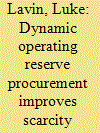|
|
|
Sort Order |
|
|
|
Items / Page
|
|
|
|
|
|
|
| Srl | Item |
| 1 |
ID:
162890


|
|
|
|
|
| Summary/Abstract |
This article discusses a new method for the sizing of operating reserves by electric power system operators. Operating reserves are used by system operators to deal with unexpected variations of demand and generation, and maintain a secure operation of the system. This becomes increasingly challenging due to the increasing share of renewable generation based on variable resources. This paper revisits the current sizing method applied in Belgium, which is based on a static approach that determines the required capacity once a year. The presented dynamic sizing method determines the required capacity on a daily basis, using the estimated probability of facing a system imbalance during the next day. This risk is estimated based on historical observations of system conditions by means of machine learning algorithms. A proof of concept is presented for the Belgian system, and demonstrates that the proposed methodology improves reliability management while decreasing the average capacity to be contracted. The method is compliant with European market design, and the corresponding regulatory framework, and is of particular interest for systems with a high share of renewable generation. For these reasons a gradual implementation in Belgium towards 2020 has been decided based on the results of this study.
|
|
|
|
|
|
|
|
|
|
|
|
|
|
|
|
| 2 |
ID:
177111


|
|
|
|
|
| Summary/Abstract |
Competitive electricity markets can procure reserve generation through a market in which the demand for reserves is administratively established. A downward sloping or stepped administrative demand curve is commonly termed an operating reserve demand curve (ORDC). We propose a dynamic formulation of an ORDC with generator forced outage probabilities conditional on ambient temperature to implement scarcity pricing in a wholesale electricity market. This formulation improves on common existing methods used by wholesale market operators to articulate ORDCs by explicitly accounting for a large source of observed variability in generator forced outages, whereby for a fixed load, more reserves are required during times of extreme heat and cold to maintain a constant risk of reserve shortage. Such a dynamic ORDC increases social welfare by $17.1 million compared to current practice in the PJM Interconnection during a high load week in a welfare-maximizing electricity market with co-optimized procurement of energy and reserves. A dynamic ORDC increases reserve prices under scarcity conditions, but has minimal effects on total market payments. The results are directly relevant to the modeled two-settlement electricity market in PJM, which is currently undergoing enhancements to its ORDC.
|
|
|
|
|
|
|
|
|
|
|
|
|
|
|
|
| 3 |
ID:
177319


|
|
|
|
|
| Summary/Abstract |
Resolving the resource adequacy problem has been usually entrusted to the imposition of some kind of long-term capacity requirements or to forward markets. The Operating Reserve Demand Curve (ORDC), which is linked to short-term market conditions and does not require central planning, has been presented as an alternative system with which to ensure long-term resource adequacy in the market. Using hourly data from the Texas ERCOT market between January 2015 and February 2019, we empirically show that ORDC prices are significantly negatively affected by wind generation. We find that, if wind generation is relatively low, a 1% increase in wind generation decreases the ORDC price by around 0.15–0.1%. This fact may preclude the ORDC from providing long-term price signals and price stability to generators. Moreover, we also find that if wind generation is greater than 9000 MW, the ORDC price is expected to be zero, which may further disincentive to increase generation capacity –especially dispatchable capacity that may be needed as a backup if the wind is not blowing.
|
|
|
|
|
|
|
|
|
|
|
|
|
|
|
|
| 4 |
ID:
190593


|
|
|
|
|
| Summary/Abstract |
Across several power systems with market frameworks, policy-makers are proposing that balancing flexibility requirements emerging during energy transition be addressed through new reserve product markets. However, these may introduce additional costs, constraints and complexity, and even encroach upon the functions of existing operational practices. Thus, policy-makers need to assess and compare flexibility design options, and quantifying system flexibility capabilities based on current and expected resource mixes can assist in achieving this. In this article, we offer a practical method to quantify the time-varying spectrum of upwards and downwards flexibility capabilities in systems, and subsequently apply it to historical and projected resource mixes in two regions of the Australian National Electricity Market. Our results suggest that with higher penetrations of renewable energy: (1) downwards flexibility margins can be exhausted around noon if wind and solar are unable or unwilling to provide it, (2) upwards flexibility becomes more scarce during morning and evening peak demand events and (3) a greater portion of upwards flexibility is provided by energy-limited resources. Given these trends, we recommend that policy-makers examine how existing operational practices can be augmented to elicit upwards flexibility provision, and that duration specifications and sustained footroom procurement be considered for reserve products.
|
|
|
|
|
|
|
|
|
|
|
|
|
|
|
|
|
|
|
|
|